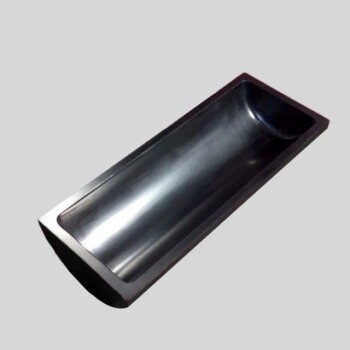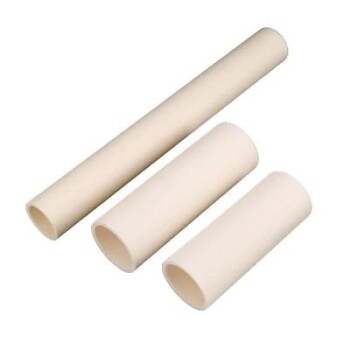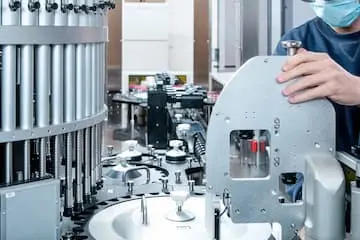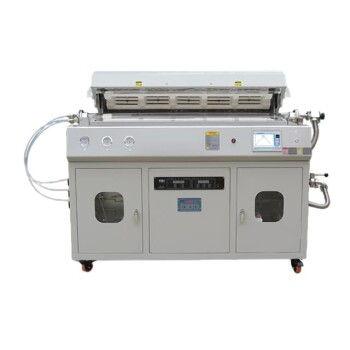A tube furnace is an electric heating device that is used in chemistry for the synthesis of various inorganic and organic compounds. It consists of a cylindrical tube surrounded by a heating mantle and is made from materials such as quartz, alumina, graphite, and metals. The tube furnace can be controlled via a control panel and can reach high temperatures. It is used for a wide range of processes including ageing, annealing, coating, drying, hardening, calcinations, degassing, sintering, soldering, tempering, and thermocouple calibration. Tube furnaces can also be categorized based on orientation and tube shape.
Toggle Categories
Get Instant Support
Choose your preferred way to connect with our team
-
Get Free Quote Fill out form for detailed pricing
-
Send Email Detailed inquiry support
-
WhatsApp Quick mobile chat
Response Time
Within 8 hours on working days, 24 hours on holidays
tube furnace

Vacuum Hot Press Furnace Heated Vacuum Press Machine Tube Furnace
Item Number : KT-VTP

Vacuum Sealed Continuous Working Rotary Tube Furnace Rotating Tube Furnace
Item Number : KT-CRTF

1400℃ Laboratory Quartz Tube Furnace with Alumina Tube Tubular Furnace
Item Number : KT-TF14

1700℃ Laboratory Quartz Tube Furnace with Alumina Tube Tubular Furnace
Item Number : KT-TF17

Multi Zone Laboratory Quartz Tube Furnace Tubular Furnace
Item Number : KT-MTF

Vertical Laboratory Quartz Tube Furnace Tubular Furnace
Item Number : KT-VTF

Laboratory Vacuum Tilt Rotary Tube Furnace Rotating Tube Furnace
Item Number : KT-RTF

Carbon Graphite Boat -Laboratory Tube Furnace with Cover
Item Number : KM-D10

High Temperature Alumina (Al2O3) Furnace Tube for Engineering Advanced Fine Ceramics
Item Number : KM-C06
We have the best tube furnace solutions that will exceed your expectations regardless of your budget. Our extensive portfolio offers a variety of standard solutions suitable for various needs, and our bespoke design service can meet almost any unique customer requirement. Our tube furnaces are available in various models, including single or multi-zone, horizontal/vertical, split & rotating models, and continuous or batch rotary tube furnaces.
Applications of Tube Furnace
- Material synthesis and processing
- Heat treatment and annealing of metals and alloys
- Thermal analysis and characterization of materials
- Powder sintering and compaction
- Crystal growth and epitaxial film deposition
- Catalytic reaction studies under controlled atmospheres
- High-temperature testing and experimentation
- Research and development in materials science and engineering
- Production of advanced ceramics and composites
- Production of carbon nanotubes and graphene
Advantages of KINTEK Tube Furnace
- Mature technology with a simple furnace structure
- Low power consumption and high thermal efficiency
- Easy to operate and control with continuous production
- Fast heating and good operation performance
- No pollution to the environment
- Can control temperature easily and remotely with fine adjustment
- Multiple furnaces can be combined for large-scale production
- Suitable for various applications, including physiochemical processing of loose materials, cracking of gas, and more
- High-quality heating element with a long service life
- Optional exhaust port and inert gas inlet
- Programmable controllers with adjustable over-temperature protection and safety lock system for door opening and cutting heating.
Our tube furnace is the perfect fit for your laboratory equipment needs. With its extensive product line, it offers a standard solution at a reasonable price. Its unique feature is the custom design service that caters to your specific requirements. The furnace is available in different models, including single or multi-zone, horizontal/vertical, split & rotating, continuous or batch rotary tube furnaces. It is equipped with two or more heating zones and can produce temperatures up to 1800°C. Our tube furnace is ideal for applications requiring relatively small workspaces and features such as multiple zones, independently controlled.
FAQ
What Is A Tube Furnace?
Laboratory tube furnace is one classic external heating high temperature tube furnace, also named hot wall heating furnace.
According to the different working temperature, furnace tube material usually can be transparent quartz tubes, high purity alumina ceramic tubes and high strength metal alloy tubes.
To meet different thermal researching purposes, tube furnace can be designed with multi heating zones, so as to have a flexible control of temperature gradient in the tube working chamber; furnace tube can work with a controlled atmosphere working environment or a high vacuum working environment.
How Does A Tube Furnace Work?
Tube furnace heating elements are placed surrounding the cylindrical cavity, furnace can only heat the samples in the cylindrical cavity through indirect thermal radiation, since furnace tube can prevent sample material from contacting with furnace heating elements and insulation materials, so tube furnace creates a clean isolated heat chamber and reduce risks of the sample material contaminating by the furnace.
What Is The Application For Tube Furnace?
Tubular furnace is mainly used in metallurgy, glass, heat treatment, lithium anode and cathode materials, new energy, abrasives and other industries, and is a professional equipment for measuring materials under certain temperature conditions.
Tube furnace features simple structure, easy operation, easy control and continuous production.
Tube furnace is also widely applied in the CVD (chemical vapor deposition) and plasma enhanced CVD systems.
How Many Different Types Tube Furnace?
Tube furnace can work with different mechanical functions smoothly, so there are many different types tube furnace variations for different experiment purposes, typical furnace furnaces are as below:
- Horizontal tube furnace
- Vertical tube furnace
- Split tube furnace
- Rotary tube furnace
- Tilting tube furnace
- Sliding tube furnace
- Fast heating and cooling tube furnace
- Continuous feeding and discharging tube furnace
What Are The Advantages Of Using A Tube Furnace?
What Safety Precautions Should Be Taken When Using A Tube Furnace?
REQUEST A QUOTE
Our professional team will reply to you within one business day. Please feel free to contact us!
Related Articles

Muffle vs. Tube Furnace: How One Choice Prevents Costly Research Failures
Choosing between a muffle and tube furnace is critical. Learn the core difference to avoid ruining experiments and wasting your lab's budget.

Why Do Your Nickel Alloys Discolor? The Four Hidden Culprits in Your Furnace and How to Defeat Them
Discover the four main causes of nickel-based alloy discoloration during heat treatment and learn how the right lab equipment can ensure flawless results.

Why Your High-Temperature Furnace Elements Keep Failing (And How to Stop It)
Discover the hidden causes of MoSi2 heating element failure, like pesting and chemical attack, and learn how to achieve reliable, repeatable results.

From Crack to Complete: A Scientist's Guide to Eliminating Catastrophic Tube Furnace Failures
Prevent costly tube furnace bursts. Learn the key causes like thermal shock and material incompatibility, and discover the right strategy to ensure safety and data integrity.

Beyond 1000°C: How Precision Furnaces Conquer the Hidden Enemy of Repeatable Results
Struggling with inconsistent results from sintering or ashing? Discover how overcoming thermal instability with advanced muffle furnaces is key to reproducible research.

AI completes muffle furnace scientific research graphing in one minute.
How to use nano banana to create scientific illustrations

Risk-Proof Your Lab: How to Choose a Vacuum Pump That Avoids Costly Failures
Learn how to choose reliable lab vacuum pumps to avoid costly failures. Assess chemical risks, throughput needs & safety for optimal performance.

How to Choose and Optimize Water Circulating Vacuum Pumps for Your Lab
Learn how to choose and optimize water circulating vacuum pumps for lab applications, balancing efficiency and reliability.

How Vacuum Induction Melting Prevents Catastrophic Material Failures in Critical Components
Discover how Vacuum Induction Melting (VIM) prevents material failures in aerospace, nuclear, and EV components by eliminating atomic-level contamination.

How Vacuum Induction Melting Elevates High-Performance Alloy Production
Discover how Vacuum Induction Melting (VIM) enhances alloy purity, reduces defects, and optimizes costs for aerospace and energy sectors.

How Vacuum Induction Melting Powers Superior Material Performance in Critical Industries
Discover how Vacuum Induction Melting (VIM) ensures 99.99% pure alloys for aerospace and medical industries, boosting performance and compliance.

How Freeze-Drying Cuts Transport Costs by 90% in Critical Logistics
Freeze-drying slashes transport costs by 90% in logistics for space, military, and disaster relief by reducing weight and volume. Learn how it works.

Why Freeze-Drying is Indispensable for Preserving Sensitive Samples
Freeze-drying preserves sensitive samples by sublimation, maintaining molecular integrity and enabling stable, room-temperature storage. Essential for proteins, vaccines, and volatile compounds.

How Freeze-Drying Protects Delicate Biological Structures During Water Removal
Freeze-drying preserves biological samples by removing water without structural damage, ideal for vaccines, enzymes, and microbial cultures. Learn how it works.

Why Ultra-Low Temps are Non-Negotiable: The Science Behind Preserving Critical Biological Materials
Discover why ultra-low temperature freezers (-86°C) are vital for preserving cells, proteins, and vaccines. Learn the science behind ULT storage best practices.

Polytetrafluoroethylene (PTFE): How low friction coefficient promotes industrial progress
Explore the unique advantages of polytetrafluoroethylene (PTFE)'s low coefficient of friction and analyze how it promotes progress and innovation in industrial technology in terms of reducing wear and improving equipment efficiency.

PTFE's high temperature and corrosion resistance: Why it is indispensable in industry
The unique advantages of polytetrafluoroethylene (PTFE) in high temperature and corrosion resistance analyze why it has become an indispensable material in industry, especially in applications in harsh environments.

Precision Ceramic Materials for Energy Conversion Applications
Overview of various ceramic materials used in energy conversion technologies, including heaters, piezoelectric ceramics, and solid oxide fuel cells.

Advanced Technologies for Precision Ceramics
Explores key technologies and preparation methods for precision ceramic components, highlighting their applications and challenges.

New Rapid Sintering Technologies for Advanced Ceramics
Explores advanced ceramic materials, their properties, and various rapid sintering techniques to enhance their performance.


